On this page... (hide)
- 1. General Notes
- 2. Groups and Group-specific notes
- 2.1 Gruppo 1: Selectively adhesive wall or panel coverings for display
- 2.2 Gruppo 2: Soft Robotics exploiting directional friction and/or adhesion
- 2.3 Gruppo 3: Adhesive conveyors "Gekoveyor"
- 2.4 Gruppo 4: Gecko or microspine camera and flash mounts
- 2.5 Gruppo 5: SEM fixturing and mounting
- 2.6 Gruppo 6: Non-ejecting compliant grippers
- 2.7 Gruppo 7: Compact, low power brake or clutch
- 2.8 Gruppo 8: Selectively lockable endoscope
- 2.9 Gruppo 9: Easily applied/removed bandages
1. General Notes
General notes from talking with all the groups and with others about the ideas collected here.
1.1 References
A useful link for everybody: Ron Fearing's (U.C. Berkeley) comprehensive gecko-inspired adhesives bibliography
1.2 Directional behaviors and opportunities
The gecko-inspired material has two key functional properties: it has adhesion and it is directional.
- Adhesion: the material currently sticks well to smooth surfaces like glass, plastic, metal, shiny leather, etc. We have reason to believe that future versions will stick to slightly rough materials (e.g. interior plastered and painted walls). Future versions may also work in the presence of water, through the addition of "functionalizing" (see, notes for Group 9 below).
- Directionality: Whenever the normal pressure can be slightly positive, we become more interested in anisotropy than adhesion. Examples include ideas from Group 7 and Group 8 below to employ low-energy brakes, ratchets and other locking devices. This point possibly also applies to ideas from Group 2 and Group 6.
- In braking or locking applications, a very small effort (e.g. from piezoelectric or electrostatic actuation) could engage and disengage the material. Approximately 50um should be enough motion in the direction perpendicular to the surface. It could be especially suited to low energy and compact applications where bulkier solutions (e.g. pneumatics) are not desired. Depending on the application, the material could be used either with a smooth surface or with two pads brought together face to face (see "Silent Velcro, below). Also note that in these directional applications, it should be possible to use a stiffer, more durable material (e.g. hard polyurethane) than when trying to maximize adhesion. In addition, the details of the wedge-shaped features might be varied slightly for robustness and ease of disengagement.
Silent Velcro: The material sticks extremely well to itself and has a highly directional behavior when opposed pads are brought together, face to face. This opens up the idea of attachment material that, unlike Velcro, does not require significant pressure to engage the hooks and loops and does not require significant effort, accompanied by a shredding noise, to detach. The opposed pads sustain large shear forces. If the normal adhesion is not large enough, it could be enhanced by magnets or electrostatic charge. Note that small rare earth magnets are already used in iPad covers, laptops, purses, etc. Interestingly, they have relatively poor ability to sustain shear loads, which is exactly what the directional "silent velcro" would be best at.
Dynamic loading: The material responds almost immediately to the application or release of shear forces. This makes it suitable for dynamic applications such as perching UAVs.
Effect of fibers in backing layer: A group at U. Mass. Amherst has experimented with [[http://onlinelibrary.wiley.com/doi/10.1002/adma.201104191/full|sheeta of PDMS or similar material with a fabric backing] . This is non-directional approach, but can hold large loads.
- Thanks also to Maurizio for finding a patent on the use of fibers in adhesive belts or tapes to selectively control the peeling direction (US 8377542 B2).
Commercial examples of anisotropic materials
There are a few readily available examples of highly directional or anisotropic materials. Some of these could be obtained by the groups for Critical Function or Critical Experience prototypes, using some creativity.
- Directional lint brushes -- often used to remove pet hair and lint from clothing.
- Example: Reversible lint brush
- Climbing skins for back-country skiing.
- Also Kicker skins which are less extreme.
2. Groups and Group-specific notes
9 aprile: Updates below in red
2.1 Gruppo 1: Selectively adhesive wall or panel coverings for display
- Margherita Mencattelli, Antonella Verbeni, Lorenzo Bassi Luciani, Marco Salerno
- Meeting time: luned́ alle 14:30
- Email: m [bot] mencattelli [sticky] sssup [bot] it,a [bot] verbeni [sticky] sssup [bot] it,l [bot] bassiluciani [sticky] sssup [bot] it,m [bot] salerno [sticky] sssup [bot] it
- Possible topic = Directionally adhesive wallpaper: a very large area of adhesive that could be put on a wall or other surface. Need to identify a particular use case -- perhaps for quick-change scenery in a theater or display area (e.g. in stores, galleries or convention centers). Could also be used for something like the space station - keeping posters and other items in place without gravity. Maybe onboard a ship?
- Update: Based on interviews with some jewelry shop owners and workers, the group has a more focused idea for showing jewelry and other artisan products at exhibitions. The goal is to have something very easily attached and detached many times and which can, perhaps be rolled or folded up at the end of the day (with the items still attached) and put in a safe place. Other issues included schemes for coloring or printing the material to make the preferred orientation clear.
- This is one example of a group that has done something closer to an "Experience Prototype" than a "Critical Function" prototype for this short course. Gruppo 9 is also doing an Experience Prototype.
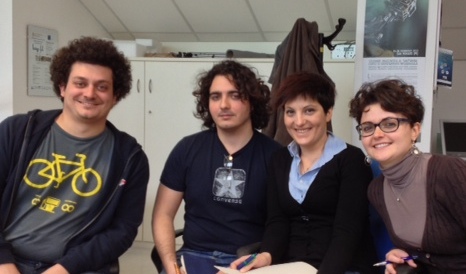
Lorenzo, Marco, Antonella, Margherita
2.2 Gruppo 2: Soft Robotics exploiting directional friction and/or adhesion
- Alessio Ghionzoli, Giacomo Santerini, Laura Margheri
- Meeting time: marted́ alle 12:00
- Email: laura [bot] margheri [sticky] sssup [bot] it,a [bot] ghionzoli [sticky] sssup [bot] it,g [bot] santerini [sticky] sssup [bot] it
- Possible topic = Soft robotics applications. Perhaps like the Velvet Fingers gripper by Prof. Antonio Bicchi and colleagues (look at Figure 7). Or perhaps something even softer. This could be arranged by using a thin, flexible fabric backing for the adhesive instead of tiles as we have been using. See, for example, the (non-directional) approach by Crosby et al. at U. Mass Amherst
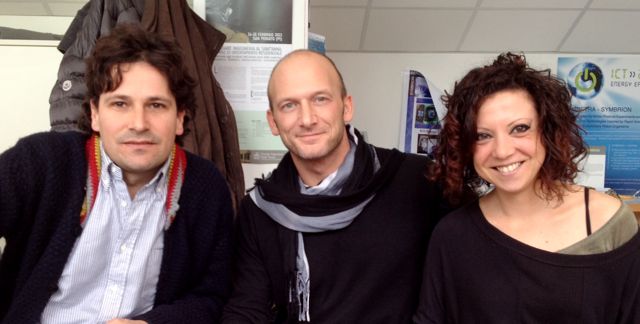
Alessio, Giacomo, Laura
2.3 Gruppo 3: Adhesive conveyors "Gekoveyor"
- Liyana Popova, Ali Sadeghi, Maurizio Follador, Majid Taghavi
- venerdi 16:00
- Email: liyana [bot] popova [sticky] iit [bot] it,ali [bot] sadeghi [sticky] iit [bot] it,m [bot] follador [sticky] sssup [bot] it,majid [bot] taghavi [sticky] iit [bot] it
- Possible topic = GeckoVey: a conveyor system that uses patches of directional adhesive with alternating directions to securely transport objects in 3D space. The conveyor is elastic and is stretched, an object is put on it, then it contracts to hold the object securely.

Maurizio, Ali, Liyana, Majid
- Update: The group visited Sant Goban Glassworks in Pisa. This company makes automotive glass panels. They don't use a conveyor but they do use suction grippers of silicone rubber. They find the suction system undesirable from maintenance point of view. The pneumatic system introduces oil into the compressed air which gets onto the suction cups so they leave marks on the glass. A cleaner solution would be desireable. Note that this application can be made so that it is almost pure shear, which may allow the use of a slightly stiffer and tougher material in the mold. Group will now decide if they want to switch to the glass panel handling or stick with 3D conveyor idea.
- Group has continued to develop the conveyor idea a bit. We talked about the need, if using tiles, to obtain a uniform pressure distribution which can be achieved by using a tape or tendon to ensure that loads are applied virtually at the center of the tile area.
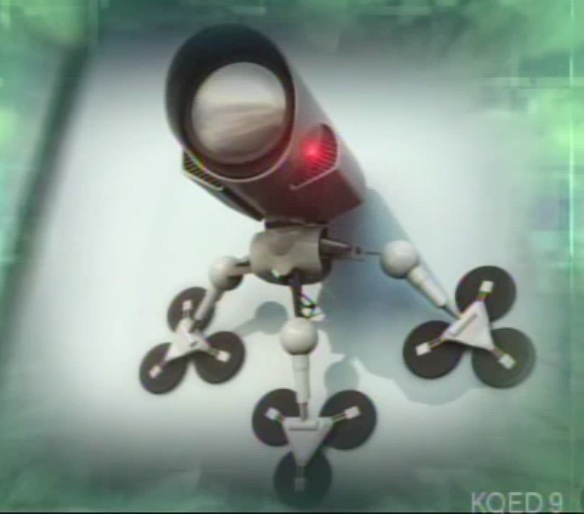
2.4 Gruppo 4: Gecko or microspine camera and flash mounts
- Francesco Clemente, Carlo.peccia, Federico Montagnani, Marco Controzzi
- marted́ alle 11:00
- Possible topic = Camera mounting for professionals or hobbyists. This is a nice idea which is slightly anticipated in the PBS NOVA video (see image at right). There is also some historical precedent for camera mounting devices coming out of design courses. The Gorilla Pod was invented by Joeben Virt, a graduate of ME10 at Stanford. One could imagine equipping the GorillaPod with directionally sticky feet using adhesives for smooth surface and microspines for rough ones.
- One could even imagine a remote-controlled camerabot that lands wherever you like. See the new (24 March 2013) video from our lab + Sean Humbert's lab.
- Update: The team looked at some new scenarios involving placing cameras in arbitrary locations (e.g. rock climbing)
- They also looked at scenarios for professional and semi-professional photographers placing lighting and flash units in arbitary locations to get just the right shade of lighting and shadow.
- Some links:
- adhesive and microspine perching mechanisms for smooth and rough surfaces, respectively.
- JPL asteroid gripper (microspine gripper for rock surfaces)
- Email: francesco [bot] clemente [sticky] sssup [bot] it,carlo [bot] peccia [sticky] sssup [bot] it,f [bot] montagnani [sticky] sssup [bot] it,m [bot] controzzi [sticky] sssup [bot] it
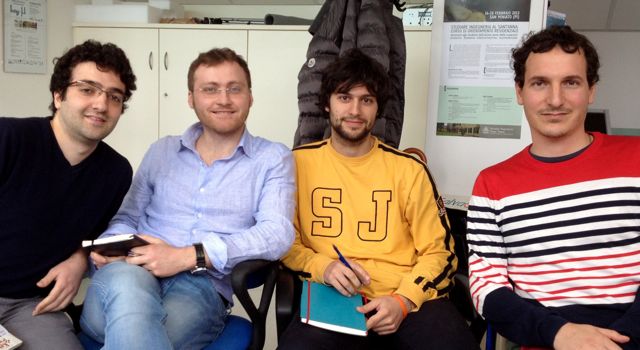
Carlo, Marco, Francesco, Federico

2.5 Gruppo 5: SEM fixturing and mounting
- Marco Donati, Giada Gerboni, Tingfang Yan, Rossella Fontana, Domenico Camboni
- Possible topic: Fixturing for use in SEM microscopy. The need for an ambient vacuum and the undesirability of using high electric or magnetic fields makes gecko adhesives a nice possible solution. There is some slightly related recent work by Metin Sitti at CMU on using dry adhesives for micro-manufacturing applications. As the linked article shows (see image at right), by playing with tip geometry one can make it easier to pick up or release objects. Of course, the highly directional adhesives that we've been looking at make this even easier...
- The group has build a Critical Function Prototype that uses two of the adhesive pads to hold small objects. The design works and will probably have a stronger grasp force if they use a tape or tendon to ensure that loads are applied virtually at the center of the tile area and so that the pressure distribution is not affect by minor alignment errors.
- Update: The group has implemented the above suggested change and indeed it grips more securely. The next step could be to try it in an SEM to verify that it functions well in vacuum.
- Email: t [bot] yan [sticky] sssup [bot] it,d [bot] camboni [sticky] sssup [bot] it,g [bot] gerboni [sticky] sssup [bot] it,r [bot] fontana [sticky] sssup [bot] it,m [bot] donati [sticky] sssup [bot] it

Tingfang, Domenico, Marco, Giada, Rossella
2.6 Gruppo 6: Non-ejecting compliant grippers
- Alessia Licofonte, Luca Cesaretti, Lorenzo Parrotta, Nino Cauli
- Possible topic = Gripping, perhaps underwater or on an asteroid in space (with microgravity). See the Velvet Fingers gripper by Prof. Antonio Bicchi and colleagues (look at Figure 7) for an idea of what is possible. Also see the recent papers by Dr. Aaron Parness at JPL at using directional arrays of microspines for asteroid gripping:
- Fruit picking -- fragile fruit that should not be squeezed with a positive normal force. Also see link above on Bicchi gripper.
- Email: l [bot] parrotta [sticky] sssup [bot] it,n [bot] cauli [sticky] sssup [bot] it,l [bot] cesaretti [sticky] sssup [bot] it,a [bot] licofonte [sticky] bioroboticsinstitute [bot] it

Nino, Alessia, Luca, Lorenzo
- Update: The group found some of the directional fabric materials (e.g. for cleaning lint from clothes) and verified that indeed it has a strongly anisotropic friction against itself or against a soft woven cloth or felt. They have made a Critical Function rough prototype and are looking at the "ejection problem" that is well known in compliant, under-actuation hands.
- Already, with anisotropic friction, the ejection problem is reduced. With the addition of adhesion (as envisaged for the final version) it would be even better for acquiring loose objects without accidentally pushing them away.
- A few sample references that address the Ejection Problem in compliant hands:
2.7 Gruppo 7: Compact, low power brake or clutch
Elisa, Marco, Iris, Alfredo
- Email: e [bot] donati [sticky] sssup [bot] it,a [bot] argiolas [sticky] sssup [bot] it,i [bot] defalco [sticky] sssup [bot] it,m [bot] mura [sticky] sssup [bot] it
- Possible topic = A braking or locking system for a lightweight and energy efficient application. Something that can be locked/unlocked with very little effort. Could be either using the directional adhesive against a smooth surface or against itself ("silent velcro" idea).
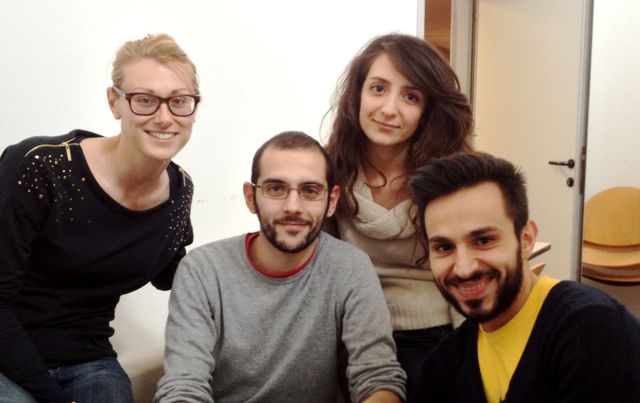
Elisa, Marco, Iris, Alfredo
- Update The group has made a couple of prototypes of a rotary system. You can easily feel the difference. In fact, the mechanism with adhesive pads against a smooth surface seems to have a nicer action than the mechanism with pads face to face. It is less sensitive about alignment. The maximum friction is not as high, but it could be useful in a torque limiter or over-running clutch application.
- A nice feature is that it requires no continuous power, it can have a "latching" behavior in which a very small actuator is used only to transition between the engaged and disengaged states.
2.8 Gruppo 8: Selectively lockable endoscope
Mario, Gunter, Alicie, Lucie, Martina
- Email: G [bot] Kanitz [sticky] sssup [bot] it,m [bot] milazzo [sticky] sssup [bot] it,lucie [bot] viry [sticky] iit [bot] it,a [bot] tonazzini [sticky] sssup [bot] it,m [bot] righi [sticky] sssup [bot] it
- Possible topic = A self-locking structure. Perhaps for endoscope or related medical application? Also consider the http://www.stiff-flop.eu/Stiff Flop project. As with the idea by Gruppo 7, this could involve either the directional adhesive against a well-chosen smooth material or against itself ("silent velcro").
- Another possibility is something like the locking/unlocking device by H. Choset's group at CMU.
- Update: The group made a new mechanism using some laser-cut acrylic to get better conformability. In fact, one can clearly feel the directional behavior of the adhesive pad. As with the case for Group 7 above, it may actually work better to have the pads bear against a smooth, flat plastic surface instead of pads face to face. In any case, if using the face-to-face method, one would want to change the profile of the microwedges and perhaps the material to obtain better wear characteristics.
- Some discussion also about alignment provisions. In fact, it is difficult to ensure good local alignment on a device which is intended to be quite flexible. One solution explored by the team is to put a hinge (fulcrum) at the center of each pad.

Mario, Gunter, Alicie, Lucie, Martina
2.9 Gruppo 9: Easily applied/removed bandages
Virginia Castelli, Byungjeon Kang, Francesca Mulana, Costanza Diversi
- Possible topic = Safely removable skin or bandage materials (e.g. for burn or abrasion victims). Stretch to apply (it has patches of opposing direction) and stretch again to remove with essentially no effort and no potential to damage surfaces. Note that there have been efforts to "functionalize" adhesives for better adhesion in the presence of water:
- "Geckel" adhesive from Northwestern: http://www.nature.com/nature/journal/v448/n7151/full/nature05968.html
- MIT adhesive bandage: http://web.mit.edu/newsoffice/2008/adhesive-0218.html , Also see Article in PNAS
- more on MIT bandage efforts
- Update: Given that we do not have directional adhesives that stick well to skin or tissue (yet), this group is doing an "Experience Prototype" to explore the experience of applying, removing, controlling a controllable adhesive bandage or skin covering. They have made prototypes of paper, nastro Americano (aka duct tape) and fibers to explore these effects.
- Email: v [bot] castelli [sticky] sssup [bot] it,b [bot] kang [sticky] sssup [bot] it,f [bot] mulana [sticky] sssup [bot] it,Costanza [bot] Diversi [sticky] iit [bot] it
- There was some discussion with the materials group at IIT Genova ([[http://www.iit.it/en/people/nanophysics-material-science/senior-researcher/athanassia-athanassiou.html|Athanassia Athanassiou) about ways in which one could functionalize adhesives for better performance on wet surfaces.
- There is also a new PNAS article showing that while geckos experience much reduced adhesion on wet glass, they do better on hydrophic surfaces.
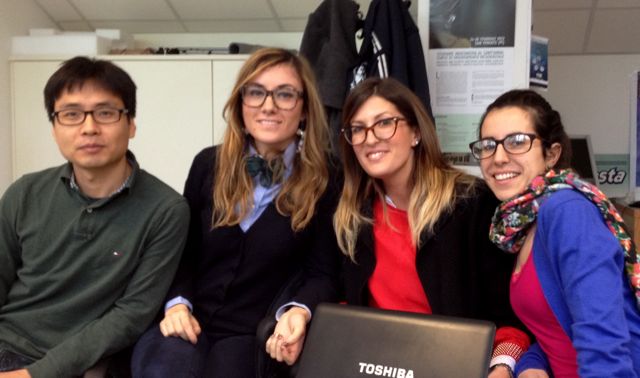
Byungjeon, Costanza, Virginia, Francesca
- Interestingly, microspines (like Spinybot) could also be used for the bandage application: http://www.bbc.co.uk/news/health-22164451


